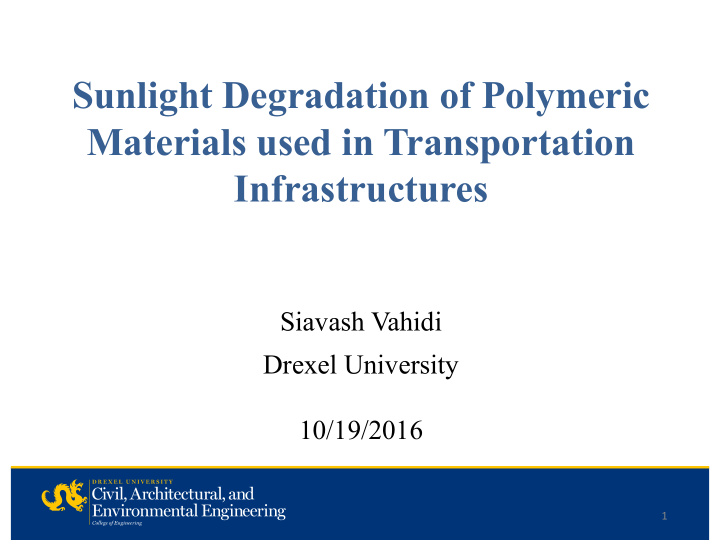



Sunlight Degradation of Polymeric Materials used in Transportation Infrastructures Siavash Vahidi Drexel University 10/19/2016 1
Introduction 2
Polymers / Properties: Ø Polymers are substances composed of a large number of repeating units resulting in large molecules that give polymers their specific properties. Ø Being used increasingly in civil engineering applications. • Mechanical properties • Chemical Properties • Economical Materials 3
Applications: Ø Polymer Modified Asphalt Ø FRP Ø ADA Mats Ø Polymer Pipes Ø Marine Structures Ø Roof Coating Ø Slope erosion control 4
Sunlight Radiation: Ø Expected to have a service life of at least a few decades. Ø Many applications require the polymer to be exposed to the sunlight. Ø Long-term performance against sunlight should be studied. Ø A combination of electromagnetic waves with different wavelengths. Planck–Einstein Equation Ultraviolet (UV) : 295 nm- 385 nm Visible Light: 385 nm- 700 nm Infrared (IR): > 700 nm 5
Sunlight Induced Degradation: Ø Chain scission Chain scission around the ester group in Polyester Ø De-crosslinking 6
Exposure Methods 7
Outdoor Exposure: Ø Most realistic results Ø Time consuming § ASTM D5970 • 45˚ Angle • Facing South 8
Laboratory Exposure (Weatherometer): Ø Accelerated degradation Ø Controlled environment Ø Xenon lamp Ø Inner/Outer filters Ø Capable of simulating the natural sunlight radiation more closely than other artificial light sources. 9
Degradation Parameters (Drexel Experiments) 10
Drexel Experiments: Ø Materials: Structural HDPE ADA Mats (Polyester, Polyurethane, Epoxy) Ø Exposure: Test coupons are placed in an Atlas Xenon Weatherometer (Ci-4000) and are exposed to different levels of irradiation, temperature, and relative humidity. 11
Degradation Parameters (HDPE): Ø Tensile Test: The tensile properties were used to assess the mechanical properties of the HDPE material. 4500 hr 5000 hr 12
Degradation Parameters (HDPE): Ø Oxidative Induction Time (OIT): Chemical degradation was monitored by OIT test. Ø Samples are heated up under a 200 ⁰ C. nitrogen atmosphere to Oxygen is then introduced and the length of time from the onset of degradation is measured. 13
Degradation Parameters (ADA Mat): Ø Abrasion Test: Mechanical degradation was measured by an abrasion test device made at Drexel university. 14
Degradation Parameters (ADA Mat): Ø Color Change: The color of the ADA coupons was measured using a spectrocolorimeter (X-rite RM200QC). The color difference, D E value, was measured for each coupon. 15
Surface Morphology: 0 Hours 5000 Hours 3000 Hours 0 Hours 16
Outdoor Exposure: Test coupons are also exposed to the natural outdoor environment (ASTM D5970) in Gainsville, FL by our colleagues at the University of Northern Florida (UNF) and will be sent back to Drexel for further testing for correlation purposes. 17
Correlation Methods: Parameters to be considered: Ø Higher irradiance levels are used to accelerate the degradation. It can result in unnatural chemical degradation. Ø Cage effect. Ø Different regions of the light spectrum have different degradation efficiency on different polymers. Ø UV stabilizers (change response to UV region) Ø Polymer color (change response to visible region) 18
Thank you for your attention! Questions or Comments?
Recommend
More recommend